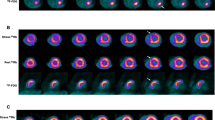Abstract
Purpose
We compared the prognostic value of 99mTc-tetrofosmin single-photon emission computed tomography (SPECT) after nitrate administration and positron emission tomography (PET) with 18F-fluorodeoxyglucose (FDG) in patients with ischaemic left ventricular (LV) dysfunction.
Methods
Eighty-nine patients with previous myocardial infarction and LV dysfunction (LV ejection fraction 33 ± 10%) underwent 99mTc-tetrofosmin SPECT under control conditions (baseline) and after sublingual administration of 10 mg of isosorbide dinitrate (nitrate). Within 1 week, all patients underwent PET imaging with 18F-FDG. Four patients were excluded because of inadequate FDG uptake caused by severe diabetes. Follow-up data were obtained by phone contact with patients and by review of hospital or physicians’ records. Cardiac death, myocardial infarction and late revascularisation for unstable angina were considered as events. Follow-up data were not available in three patients. Follow-up was 96% complete at a mean period of 29 ± 19 months.
Results
At baseline SPECT, 59 (72%) patients had evidence of viable myocardium, while 23 did not. Of these latter patients, 12 (52%) demonstrated viable myocardium after nitrate and 13 (56%) had preserved metabolic activity. Cardiac events (cardiac death, myocardial infarction and late revascularisation for unstable angina) occurred in 24 (29%) patients. Event-free survival was similar in patients with and patients without viable myocardium at baseline SPECT (p = 0.8). In contrast, event-free survival was lower in patients with viable myocardium at nitrate SPECT and PET compared to those without viable myocardium (both p<0.05).
Conclusion
In patients with ischaemic LV dysfunction, the prognostic value of SPECT imaging after nitrate is comparable to that of PET metabolic imaging.


Similar content being viewed by others
References
Patterson RE, Pilcher WC. Assessing myocardial viability to help select patients for revascularization to improve left ventricular dysfunction due to coronary artery disease. Semin Thorac Cardiovasc Surg 1995;7:214–26.
Allman KC, Shaw LJ, Hachamovitch R, Udelson JE. Myocardial viability testing and impact of revascularization on prognosis in patients with coronary artery disease and left ventricular dysfunction: a meta-analysis. J Am Coll Cardiol 2002;39:1151–8.
Travin MI, Bergmann SR. Assessment of myocardial viability. Semin Nucl Med 2005;35:2–16.
He ZX, Yang MF, Liu XJ, Shi RF, Gao RL, Hu SS, et al. Association of myocardial viability on nitrate-augmented technetium-99m hexakis-2-methoxylisobutyl isonitrile myocardial tomography and intermediate-term outcome in patients with prior myocardial infarction and left ventricular dysfunction. Am J Cardiol 2003;92:696–9.
He W, Acampa W, Mainolfi C, Menna F, Sorrentino AR, Petretta M, et al. Tc-99m tetrofosmin tomography after nitrate administration in patients with ischemic left ventricular dysfunction: relation to metabolic imaging by PET. J Nucl Cardiol 2003;10:599–606.
Cuocolo A, Petretta M, Nicolai E, Pace L, Bonaduce D, Salvatore M, et al. Successful coronary revascularization improves prognosis in patients with previous myocardial infarction and evidence of viable myocardium at thallium-201 imaging. Eur J Nucl Med 1998;25:60–8.
Acampa W, Cuocolo A, Petretta M, Bruno A, Castellani M, Finzi A, et al. Tetrofosmin imaging in the detection of myocardial viability in patients with previous myocardial infarction: comparison with sestamibi and Tl-201 scintigraphy. J Nucl Cardiol 2002;9:33–40.
Bonow RO, Dilsizian V, Cuocolo A, Bacharach S. Identification of viable myocardium in patients with chronic coronary artery disease and left ventricular dysfunction. Comparison of thallium scintigraphy with reinjection and PET imaging with 18F-fluorodeoxyglucose. Circulation 1991;83:26–37.
Cohen J. A coefficient of agreement for nominal scales. Educ Psychol Meas 1960;20:37–46.
Fleiss JL. Statistical methods for rates and proportions, 2nd ed. New York, NY: Wesley and Sons; 1981, p. 217–225.
Altehoefer C, Kaiser HJ, Dorr R, Feinendegen C, Beilin I, Uebis R, et al. Fluorine-18 deoxyglucose PET for assessment of viable myocardium in perfusion defects in 99mTc-MIBI SPET: a comparative study in patients with coronary artery disease. Eur J Nucl Med 1992;19:334–342.
Dilsizian V, Arrighi JA, Diodati JG, Quyyumi AA, Alavi K, Bacharach SL, et al. Myocardial viability in patients with chronic coronary artery disease. Comparison of 99mTc-sestamibi with thallium reinjection and [18F]fluorodeoxyglucose. Circulation 1994;89:578–87.
Sciagrà R, Pellegri M, Pupi A, Bolognese L, Bisi G, Carnovale V, et al. Prognostic implications of Tc-99m sestamibi viability imaging and subsequent therapeutic strategy in patients with chronic coronary artery disease and left ventricular dysfunction. J Am Coll Cardiol 2000;36:739–45.
Desideri A, Cortigiani L, Christen AI, Coscarelli S, Gregori D, Zanco P, et al. The extent of perfusion-F18-fluorodeoxyglucose positron emission tomography mismatch determines mortality in medically treated patients with chronic ischemic left ventricular dysfunction. J Am Coll Cardiol 2005;46:1264–9.
Siebelink HM, Blanksma PK, Crijns HJ, Bax JJ, van Boven AJ, Kingma T, et al. No difference in cardiac event-free survival between positron emission tomography-guided and single-photon emission computed tomography-guided patient management: a prospective, randomized comparison of patients with suspicion of jeopardized myocardium. J Am Coll Cardiol 2001;37:81–8.
Kaul S. Response of dysfunctional myocardium to dobutamine. The eyes see what the mind knows. J Am Coll Cardiol 1996;27:1608–11.
Author information
Authors and Affiliations
Corresponding author
Rights and permissions
About this article
Cite this article
Sorrentino, A.R., Acampa, W., Petretta, M. et al. Comparison of the prognostic value of SPECT after nitrate administration and metabolic imaging by PET in patients with ischaemic left ventricular dysfunction. Eur J Nucl Med Mol Imaging 34, 558–562 (2007). https://doi.org/10.1007/s00259-006-0304-2
Received:
Accepted:
Published:
Issue Date:
DOI: https://doi.org/10.1007/s00259-006-0304-2




